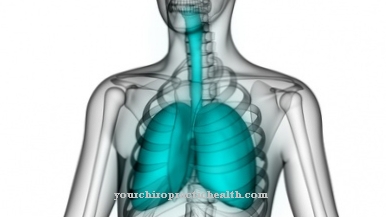With Nociception is a complex interplay of nerve stimuli that lead to pain due to mechanical, chemical or thermal stimuli in pain-sensitive tissue types in humans. The direct pain-inducing stimuli are transmitted to the CNS by specialized sensory nerves, the nociceptors. The centers in the brain responsible for this form the corresponding pain sensation from the stimuli received by the nociceptors.
What is nociception?

Nociception includes all nerve stimuli that are reported by specialized sensory nerves, the nociceptors, via afferent fibers to certain brain centers. The nerve stimuli themselves are triggered by surrounding cells that are subject to mechanical, thermal or chemical injuries.
The damaged cells release messenger substances that are capable of triggering action potentials in the nociceptors, which are reported to the brain for further processing. The responsible brain centers collect the pain stimuli, evaluate them and use them to generate - normally - an appropriate pain sensation.
There are three different types of nociceptor available for recording the mechanical, chemical and thermal stimuli emanating from cells under stress or even destroyed. On the one hand, there are the mechanoreceptors, which are specialized in mechanical stimuli, which have A-delta fibers that conduct relatively quickly and are surrounded by a myelin sheath. On the other hand, there are polymodal nociceptors that respond to mechanical as well as chemical and thermal stimuli and also have A-delta fibers, which, however, are only weakly myelinated. The third class of nociceptors are polymodal pain sensors, which have non-myelinated C-fibers and a low transmission speed of around 1 meter per second. A-delta fibers, on the other hand, forward their action potential at around 20-30 meters per second.
Function & task
One of the main tasks of nociception is the almost instantaneous release of pain in the event of imminent danger. In these cases, nociception enables the generation of pain with a warning character. The sharp and stabbing primary pain that occurs unexpectedly immediately after a dangerous mechanical, thermal or chemical exposure is usually triggered by specialized mechanoreceptors or by polymodal nociceptors. Both classes of sensory nerves have the fast A-delta fibers.
They are able to generate pain sensations that can trigger knee-jerk protective reactions in order to avert an imminent danger. For example, if you accidentally touch the hot stove top, your hand will snap back reflexively to avoid the risk of burns. Impending injuries or injuries that have already occurred, for example from a knife or from heavy objects that threaten to crush the foot, lead to similar reflex-like return movements of the hand or foot.
In the case of a less acute risk that does not pose an immediate threat to the body or parts of the body, the polymodal C-fibers take over the sensory absorption of the reporting cells, the conversion into neuronal action potentials and the transmission to the CNS. The pain sensation that is then generated is less easy to localize and usually feels dull and persistent than the stabbing or burning and easily localizable primary pain, such as occurs with cuts or burns.
The benefit of this type of pain sensation is thus mainly to be able to recall such situations from the episode memory in order to avoid similar situations in the future which have turned out to be unfavorable for the body. This means that the signals from the slow C-fibers are heavily processed in certain centers in the brain and linked to other sensor reports that occur at the same time. This can mean that certain sensor reports can already trigger pain sensations, although objectively no pain stimulus should be present.
The primary pain that triggers reflexes is exclusively surface pain that is relatively easy to localize. In contrast, deep pain that can develop in muscles, bones or internal organs (visceral pain) is less easy to localize.
You can find your medication here
➔ Medicines for painIllnesses & ailments
Given the complexity of nociception and the processing of the neuronal action potentials of the nociceptors into subjective pain perception, different potential problems can arise. On the one hand, neural disturbances can arise in the reception of the signals of affected cells by the nociceptors and / or the transmission of the potentials to the CNS. On the other hand, problems in the processing of the sensor signals are also conceivable, which lead to an increased or decreased pain sensation.
It is therefore possible to differentiate between nociceptive and neuropathic pain. Nociceptive pain occurs, for example, after tissue trauma or chronic inflammation of internal organs. Chronic back pain and tumor pain are also often triggered by changes in the signal-receiving endings of the nociceptors. In these cases, impaired functionality of the nociceptors leads to an altered pain perception.
Much more common are neuropathic pain, which leads to a reversible or irreversible pain sensation through a systemic change in signal processing. The signals of the nociceptors are first processed in the thalamic nuclei and, after further processing in certain regions of the cortex and the amygdala, they are also confronted with mental associations before they penetrate the consciousness with a concrete perception of pain.
An example of a pathologically excessive pain sensation is fibromyalgia syndrome, also known as soft tissue rheumatism. The disease causes muscle pain, especially in the joints. The opposite of a pathologically excessive pain sensation is a greatly reduced pain sensation. It is symptomatic of borderline disorder, which is a serious mental illness. Those affected tend to inflict injuries on themselves without feeling pain.
Much more common, however, are diseases that are symptomatically accompanied by chronic pain in the neuropathic area. Examples of this are diabetic polyneuropathy, shingles, multiple sclerosis and long-term alcohol abuse.


.jpg)










.jpg)

.jpg)
.jpg)











.jpg)